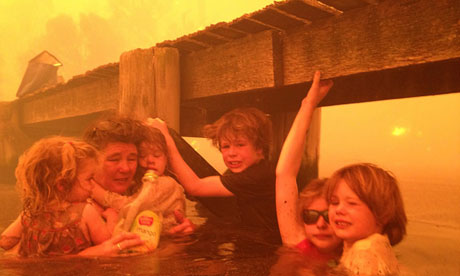
Family taking refuge under a bridge from a firestorm that erupted in Tasmania
The recent extreme heat waves, flooding and brush fires ravaging Australia may well be a wake up call for the rest of us, especially in the northern hemisphere. The sad part? All those events which have naturally occurred – such as droughts and heat waves – have intensified under the onslaught of climate change.
Meanwhile, the Australian Climate Commission has stated that only fast and deep cuts to carbon emissions can begin to reverse the trend. According to Prof. Will Steffen of the Climate Commission:
“We are very concerned that the risk of more extreme and more severe weather events is increasing as we continue to emit more and more greenhouse gases.”
Chief Commissioner Tim Flannery (author of ‘The Weather Makers’) noted in addition:
“Records are broken from time to time but record breaking weather is becoming more common as the climate shifts. Only strong preventative action, with deep and swift cuts in emissions this decade, can stabilize the climate and halt the trend toward more intense and extreme weather.”
The Commission report states that the number of record hot days in Australia Melbourne
The Australian Commission Report went on to note:
"There is little doubt that over the next several decades, changes in extreme events will increase the risks of adverse consequences to human health, agriculture, infrastructure, and the environment in Australia. "
Drought in Australia, meanwhile, has impacted key growing regions reducing crop output and leading to increased food prices.
Beyond the risks to human life the Report also noted the economic costs that extreme weather can cause. In many ways, for the economic scale of Australia, the costs of radical climate change events rival the costs in the U.S., for example from Superstorm Sandy and other intense storms. And the future projection is that these will be worsened.
The Report also noted that global warming has caused global sea levels to increase by an average of 20 cm, or more than half a foot, though our own media in the U.S. haven't made this known. But it explains many of the problems being experienced in terms of flooding from storm surges around the world.
The U.S. projections aren't any better, according to a U.S. Forest Service Report on Climate just released, e.g. http://www.treesearch.fs.fed.us/pubs/42610
As it notes,
"By the end of the 21st century, forest ecosystems in the United States will differ from those of today as a result of changing climate. Although increases in temperature, changes in precipitation, higher atmospheric concentrations of carbon dioxide (CO2), and higher nitrogen (N) deposition may change ecosystem structure and function, the most rapidly visible and most significant short-term effects on forest ecosystems will be caused by altered disturbance regimes. For example, wildfires, insect infestations, pulses of erosion and flooding, and drought-induced tree mortality are all expected to increase during the 21st century."
Insect depradation and invasion will be particularly ramped up and in an updated report in today's Denver Post it was noted that raging wildfires will occupy twice as much area by 2050 as they do now.
Even before the Forest Service Report appeared, most of us in the Rocky Mountain west expected a hellacious summer that rivals the last, including just as many wildfires (recall the Waldo Canyon last year) and heat waves that may last weeks. The worst part of it is that having moved to these parts for their scenic beauty we're now faced with seeing forests ravaged by pests, more and longer droughts, and fire seasons that may last for months. The rest of the nation will, of course, have its own climate burdens to contend with, including: floods, tornadoes, and powerful hurricanes.
Even before the Forest Service Report appeared, most of us in the Rocky Mountain west expected a hellacious summer that rivals the last, including just as many wildfires (recall the Waldo Canyon last year) and heat waves that may last weeks. The worst part of it is that having moved to these parts for their scenic beauty we're now faced with seeing forests ravaged by pests, more and longer droughts, and fire seasons that may last for months. The rest of the nation will, of course, have its own climate burdens to contend with, including: floods, tornadoes, and powerful hurricanes.
In spite of this, why is it so difficult to get people to pay attention, far less change? The obvious diconnect between information and action isn't that mystifying when two other trends are considered that have ratcheted up over the past 20-30 years. One is related to research in behavioral science, highlighting the human tendency to sift facts using emotion based filters (i.e. 'How much will this affect ME, personally?") and to favor short term payoffs over longer term adjustments or solution. The second is the sustained disinvestment in alternative energy which has been ongoing since the Reagan administration.
I would also add an additional factor has been the agnotology agenda of the Right wing corporate media, which has continually downplayed the risks, basically allowing governments to fiddle while the Earth burns. Recall here that agnotology has been defined by Stanford historian of science Robert Proctor as the trend of skeptic science sown for political or economic ends - e.g. in imparting ignorance and faux skepticism.
Sadly, even as we've learned the pace of global warming is accelerating, this agnotology meme has probably delayed us too long to prevent the worst climatic changes.
No comments:
Post a Comment